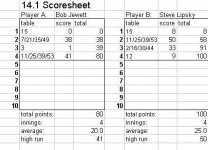Maybe this deserves a thread of its own. Unfortunately, we can't unhijack Steve's thread about how to properly count balls per inning.
Let's start with the main goals of the design:
I think it is essential to have a column for "balls on the table at the start of the inning" because there are no beads to keep the rack right. When it is your turn to shoot, it is easy to mark down the number of balls you are starting with and then jump up to shoot. Your opponent can check your announced "seven balls still up" as he goes to sit down and record his score. This also makes it very easy to review the score sheet for errors.
I think that JoeW's sheet is about right except that as mentioned before, the Penalty column could be removed if the fouls are noted with F in the score box. Thus there are these columns:
Inning Number (common)
(and for each player )
On Table (at start of inning)
Counts (balls pocketed by rack, using the / X notation for long runs)
Score (including counts and penalties)
Total
INN -- OT -- COUNTS..... -- SCORE -- TOTAL -- OT -- COUNTS..... -- SCORE -- TOTAL
As for the number of innings per sheet, I think it has to be small enough to cover most games and large enough that people with poor reading vision still have a shot at writing things down correctly. I think 30 lines is about right. If there are additional sheets used, I think it is better to have an even number of 10's on each sheet.
The sheet also needs the standard blanks for names, date, officials, and signature. Note that the players cannot be filled in until after the lag.
Let's start with the main goals of the design:
- Allows easy scoring by the players when there is no scorekeeper present.
- Allows counts of innings and high runs.
- Doesn't use too much paper, but has all info for an inning together.
- Shows clearly when a player is on two fouls.
- Shows the breaks in racks and allows checking of whether the rack score is right at any point in the match.
I think it is essential to have a column for "balls on the table at the start of the inning" because there are no beads to keep the rack right. When it is your turn to shoot, it is easy to mark down the number of balls you are starting with and then jump up to shoot. Your opponent can check your announced "seven balls still up" as he goes to sit down and record his score. This also makes it very easy to review the score sheet for errors.
I think that JoeW's sheet is about right except that as mentioned before, the Penalty column could be removed if the fouls are noted with F in the score box. Thus there are these columns:
Inning Number (common)
(and for each player )
On Table (at start of inning)
Counts (balls pocketed by rack, using the / X notation for long runs)
Score (including counts and penalties)
Total
INN -- OT -- COUNTS..... -- SCORE -- TOTAL -- OT -- COUNTS..... -- SCORE -- TOTAL
As for the number of innings per sheet, I think it has to be small enough to cover most games and large enough that people with poor reading vision still have a shot at writing things down correctly. I think 30 lines is about right. If there are additional sheets used, I think it is better to have an even number of 10's on each sheet.
The sheet also needs the standard blanks for names, date, officials, and signature. Note that the players cannot be filled in until after the lag.
